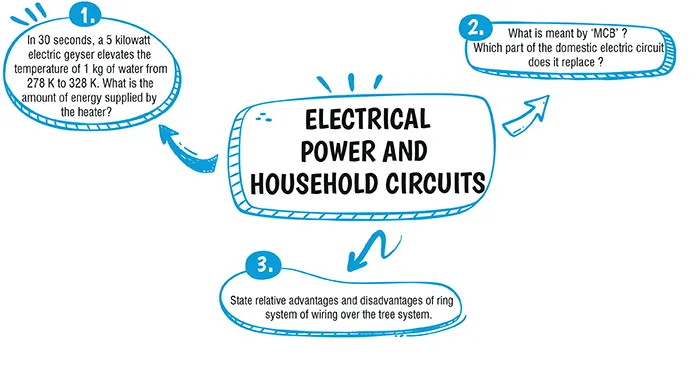Table of Contents

Ans. (b) Parallel
Explanation:
In our household, electrical appliances are connected in a parallel. It is done so as to ensure that all appliances operate at the same voltage. Because the resistance in a parallel arrangement is minimum, thus each appliance receives full voltage. When one appliance fuses, it has no effect on the operation of the other appliances.
Ans. (b) To prevent overload
Explanation:
Both are the works of an electric fuse. An electrical fuse is a safety device used in electrical systems to protect against excessive current, which can result from short circuits, overloads, or device failures. Its primary function is to interrupt or break the electrical circuit if the current exceeds a specified value, thereby preventing potential damage or fire hazards.
Explanation:
(a) Time t = 30 sec Temperature ΔT = 328 – 278 = 50 K Mass of water (m) = 1 kg So, energy supplied by the geyser (Q) = power × time = 5000 × 30 = 150000 = 1.5 × 105 J.
(b) No, it is not safe to connect this electric geyser with the live wire. Because even if the switch is off, still the geyser will have access to current. Thus, it is dangerous to the users.
Explanation:
‘MCB’ stands for miniature circuit breaker’. This a device that automatically switches off the main supply if the current drawn exceeds the prescribed upper safe limit. It can be ‘reset’ with the help of a flip-over switch. It protects the entire circuit and appliances against short circuiting, etc.
Explanation:
The relative advantages and disadvantages of ring system of wiring over the tree system are as follows:
Advantages:
(i) The tree system of wiring requires the plugs and sockets of different sizes for different current capacities while they are all of the same size in ring system of wiring.
(ii) The tree system of wiring has one fuse in one distribution line. If the fuse in one distribution line blows, it disconnects all the appliances in that distribution line. But in the ring system, a separate fuse is connected with each appliances. So if one fuse blows, it does not affect the other appliances.
(iii) The tree system of wiring is expensive while the ring system of wiring is cheaper.
(iv) It is expensive and inconvenient to install a new appliance in the tree system of wiring since it requires to put the new leads up to the distribution box, while it is easy to install a new appliance in the ring system since the appliance can be directly connected to ring mains in the room.
Disadvantages:
The only disadvantage of ring system of wiring over the tree system is that while installing a new appliance, care has to be taken that the total load on the ring circuit does not exceed the main fuse rating (i.e., generally 30 amp).
Download Mind Map of this chapter
Download NowWant to Practice Mock Tests of this chapter
Practice NowDownload Important Questions of this chapter
Download Now| Chapter No. | Chapter Name |
|---|---|
| Chapter 1 | Force Work Power and Energy |
| Chapter 2 | Simple Machines |
| Chapter 3 | Refraction of Light |
| Chapter 4 | Refraction Through Lenses |
| Chapter 5 | Spectrum |
| Chapter 6 | Sound |
| Chapter 7 | Electricity |
| Chapter 8 | Electrical Power and Household Circuits |
| Chapter 11 | Magnetic Effect of Current |
| Chapter 12 | Specific Heat Capacity and Latent Heat |
| Chapter 13 | Radioactivity and Nuclear Energy |
| Chapter Wise Important Questions for ICSE Board Class 10 Physics |
|---|
| Force Work Power and Energy |
| Simple Machines |
| Refraction of Light |
| Refraction Through Lenses |
| Spectrum |
| Sound |
| Electricity |
| Electrical Power and Household Circuits |
| Magnetic Effect of Current |
| Specific Heat Capacity and Latent Heat |
| Radioactivity and Nuclear Energy |
CBSE Important Questions Class 10
ICSE Important Questions Class 10
CBSE Important Questions Class 10
ICSE Important Questions Class 10